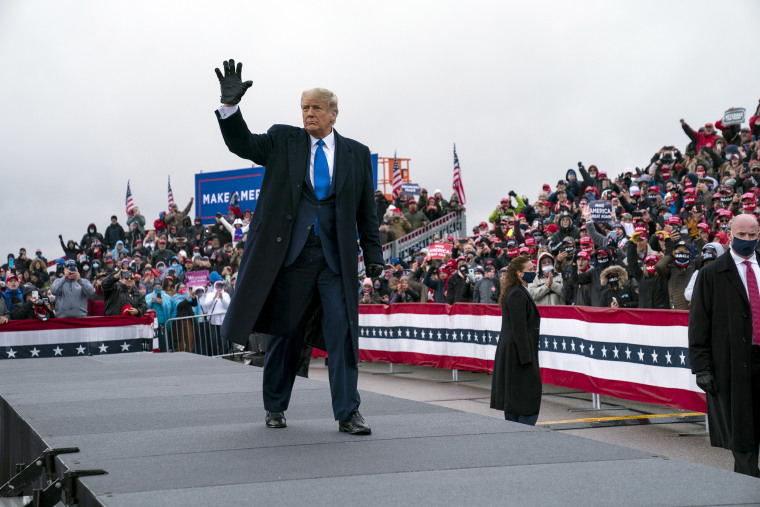LANSING, Mich. — President Donald Trump's campaign stops on Tuesday read like a rundown of some of the nation's top coronavirus hot spots.
There was Wisconsin, where the rate of positive tests has passed 25 percent. Nebraska, where health officials are reporting the highest number of hospitalizations since the start of the pandemic. And Michigan, where the number of cases has nearly doubled in recent weeks, and some medical facilities are nearing capacity amid the surge in new infections.
But at the campaign events themselves, and at similar rallies over the presidential race's waning days, the surging numbers haven't been the coronavirus issue on which he has appeared most focused.
“Covid, covid, covid, covid, covid, covid cases — do you ever notice they use the word 'cases'? Like Barron Trump has a case, sniffles, one Kleenex and he was better,” Trump told a tightly packed, mostly mask-less crowd here in Michigan's state capital, in remarks downplaying the severity of the virus.
Coronavirus cases are only up because of increased testing, he said, and media coverage of the pandemic is being used to make him look bad. Regarding testing, he said, “in many ways I hate it. We test everybody. … If I told them to cut testing in half and we cut our testing in half, they would go crazy because the cases would go down at approximately half, right?”
In the final days of his campaign, Trump is contending with a fall wave of coronavirus infections that he had once predicted wouldn’t be coming, and that people close to the campaign dismissed as an impossibility over the summer as they planned to tout an economic recovery in the homestretch of the race.
Now, the battleground states of Michigan, Minnesota, Pennsylvania and Wisconsin are being hit particularly hard with overwhelmed hospitals and rising death tolls in Wisconsin and Minnesota. Trump cannot afford to lose all four of those states, even if he is able to hold on to the rest of the states he won in 2016, and polls indicate he has consistently been trailing Democratic rival Joe Biden there for months.
But Trump's response to the fall surge has been to carry on with even more of his rallies in those areas, with no additional safety measures put in place, and to dismiss the risk. At a rally in Wisconsin over the weekend — where the state has had to set up a field hospital to contend with the onslaught of cases — Trump baselessly argued that the death toll may not be as high as it seems.
“If somebody is terminally ill with cancer and they have Covid, we report them. And doctors get more money and hospitals get more money. Think of this incentive,” Trump told the Wisconsin rally. “If somebody has a really bad heart and they are close to death, even if they're not but they have a very bad heart and they get Covid, they put it down to Covid. Other countries are putting it down to heart. So we are going to start looking at things.”
Vice President Mike Pence has continued to travel to campaign events, despite coronavirus diagnoses over the past week for at least five members of his staff or inner circle. He held an event Monday in Minnesota — where new cases, hospitalizations and deaths are spiking — that violated the state’s public health rules about large gatherings.
It's a strategy that the campaign believes holds appeal for the president's base of white working-class voters, but it has alienated other key groups, like seniors and women. Over the summer, Trump adviser Kellyanne Conway urged Trump to resume his daily coronavirus briefings to project the image of a commander in chief taking charge of a crisis as his numbers among seniors started to tumble in states like Florida. Trump’s advisers say they saw those numbers starting to come back in September.
Still, Trump has spent the race's last weeks making the case that the country is “rounding the turn” with the pandemic, blaming the fall spike in cases on an increase in testing rather than more widespread illness — even though cases have increased more than testing rates, and hospitalizations are up. Rather than urging people to practice social distancing and wear masks to try to tamp down the spikes, Trump continues to pack in supporters closely together at his rallies and doesn't require attendees to wear a mask.
And with no vaccine coming before the election, Trump has shifted the focus more to treatments in development — a message that he believes helps him, even though those medications remain inaccessible for most Americans.
“Trump’s play is to run right up the middle — continue to have massive rallies in states despite the fact that the virus is surging and hope he breaks through the defense and ends up in the end zone somehow,” said major Trump donor Dan Eberhardt. “It is brazen and bold. It is also the only play he has. He is behind and being heavily outspent.”

